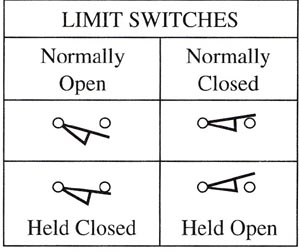Normally Open vs Normally Closed
Electrical Switch Contacts
When it comes to electrical switches and contacts, many people seem to be confused by the terms Normally Open (NO) and Normally Closed (NC). The root of the problem seems to start with the fundamental concept of what it means to be open or closed. This post attempts to clarify those concepts.
In every day terminology, movement is allowed when something is open, and movement is prohibited when something is closed. Several real-world examples are listed below.
- One can walk through an open door, but cannot walk through a closed door (unless, of course, one is physically busting through the door).
- One is allowed to shop in an open store, but must wait to shop if the store is closed.
- Employees can sign up for benefits during open enrollment, but are prohibited from making changes when enrollment is closed.
- Computer programs can read from or write to open files, but cannot access the contents of closed files.
- Water flows when the valve is open (i.e. on position), but does not flow when the valve is closed (i.e. off position).
In contrast, when it comes to electrical circuits, the terms open and closed are conceptually reversed. That is, electrons flow through a closed circuit, but do not flow through an open circuit. Therefore, the following statement is true:
- A light turns on when the circuit is closed (i.e. switch in on position), and a light turns off when the circuit is opened (i.e. switch in off position).
The easiest way to think about this is in terms of an old-fashioned electrical knife switch. From the picture below, one can clearly see that the switch cannot conduct electricity when the switch is open (as is pictured), but will conduct electricity when the switch is closed.

The typical electrical wall switch is either in the on state (i.e. electrical contacts closed) or off state (i.e. electrical contacts open). This is known as a toggle switch because it is just as normal for it to be in either state. A toggle switch takes an action to change it from one state to the other, but does not take a continuing action to hold it in either state.

A doorbell button is very different from a toggle switch. A doorbell button is normally in the unpressed state, and will only be in the pressed state for as long as it is being pressed by a finger. Therefore, it has a normal state (not pressed) and an activated state (pressed).

Doorbell buttons typically have contacts that are open in the normal, unpressed state. The contacts only close (i.e. conduct electricity) when the button is in the activated, pressed state. Therefore,the typical doorbell button is said to be Normally Open (NO).
Some buttons are made differently. For example, it is possible to get buttons that have their contacts closed (i.e. conduct electricity) when the button is in the normal, unpressed state. The contacts then open (i.e. stop conducting electricity) when the button is in the activated, pressed state. Such buttons are said to be Normally Closed (NC).
You can get buttons and other devices that have both normally open and normally closed contacts. When such devices are in their normal, not activated state, the normally closed contact is closed (i.e. conducts electricity) and the normally open contact is open (does not conduct electricity). Then, when the device is activated, the normally closed contact opens (i.e. stops conducting electricity) and the normally open contact closes (i.e. starts conducting electricity).
Sometimes you might come across the terms Held Open (HO) or Held Closed (HC).
| Acronym | Description |
|---|---|
| NO | The device's contacts are normally open, and will close (i.e. conduct electricity) when the device is activated. |
| NC | The device's contacts are normally closed, and will open (i.e. stop conducting electricity) when the device is activated. |
| HC or NOHC | The device's contacts are normally open, but the device is being used in such a way that it is being held in it's activated state. Therefore, under normal conditions, the device contacts will be closed (i.e. conduct electricity) until the force holding the device in the activated state is removed. |
| HO or NCHO | The device's contacts are normally closed, but the device is being used in such a way that it is being held in it's activated state. Therefore, under normal conditions, the device contacts will be open (i.e. not conducting electricity) until the force holding the device in the activated state is is removed. |
Limit switches are good examples of the HO and HC options. In the chart below, imagine that the triangle below the line is weight pulling the switch down.

- Normally Open - Something has to push the switch to cause the contacts to close
- Normally Closed - Something has to push the switch to cause the contacts open
- Normally Open Held Closed - Something has to continuously push the switch to keep the contacts closed; if the pushing stops the contacts will open.
- Normally Closed Held Open - Something has to continuously push the switch to keep the contacts open; if the pushing stops the contacts will close.
Magnetic window and door switches are good examples of Held switches. For example, wired security systems will generally use Normally Open switches that are Held Closed by magnets. That way, under normal circumstances, the electrical circuit is closed (i.e. conducting electricity). If the electrical circuit is opened for any reason (i.e. wire is cut, magnet falls off, door is opened, etc.) the alarm can sound.
Automatic closet lights work the opposite. The switch is Normally Closed and Held Open by a magnetic (or held pressed in by the door, etc). When the magnet moves away the switch returns to its closed state, which completes a circuit that activates a relay that turns on the light.
Programmer, Engineer